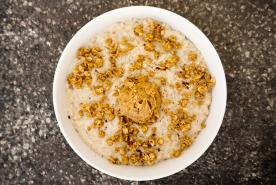April 26, 2017
By Katy Wilkens, MS, RD
Kidney-friendly diet for people on dialysis can be challenging. As a matter of fact, nutrition is so important to people with kidney disease—and so complicated—that there are nutrition specialists, called renal dietitians, to guide people with kidney disease through their diets.
Part of a kidney-healthy diet is tracking or avoiding minerals like sodium, potassium—or phosphorous. Phosphorous is tricky because it can be hidden in foods.
Why is watching phosphorus important? Your body needs some to stay healthy. But too much phosphorous in your blood pulls calcium from your bones, weakening them. That calcium goes to other parts of the body, causing serious health conditions.
Your kidneys regulate hormones and minerals, like phosphorous. When you have kidney disease, they don’t do their jobs as well as they should. That’s why you need to track how much phosphorous you’re putting into your body. In other words, by sticking to your diet, you’re doing part of the job of your kidneys.
If you’re thinking, “I already know which products to choose because I read nutrition labels,” that might be the wrong approach to understanding phosphorus contents in foods. The U.S. Food and Drug Administration does not require reporting of phosphorus on food labels, so how much phosphorus there is in a food can be hard to figure out.
How much phosphorus you should get depends on your age, gender, and how much protein you need, but good ranges for people with kidney disease are between 800–1,000 mg/day. Ask your doctor or dietitian what your last phosphorus level was and write it down to help keep track of it.
Join the NKF Blog Newsletter
Get inspirational stories and kidney disease resources delivered to your inbox every month. You'll gain practical insights and expert advice to help you better understand and manage your kidney health no matter where you are on your kidney journey. Subscribe today.
Be a Phosphorus Detective
- Check the list for words that contain the letters “phos” such as:
disodium phosphate
trisodium phosphate
disodium tripolyphosphate
potassium tripolyphosphate
tetrasodium pyrophosphate
sodium hexametaphosphate
monosodium phosphate
- Look at the order of the ingredients list. Foods contain more of an ingredient at the beginning of the list than the ones toward the end.
- See if calcium is listed on labels. Calcium and phosphorus are often found in foods in a one-to-one ratio. If there are 300mg of calcium in a food, for example, you might expect there are probably at least 300 mg of phosphorus in it.
- Look at the sodium content on labels. Processed foods often have both salt and phosphorus added to improve flavor, and to preserve foods. Avoid meals with more than 400 mg of sodium, and snacks with more than 150 mg of sodium, and you will also be cutting phosphorus.
- Do research online for phosphorus contents in foods but do know that sometimes these lists can be confusing. For instance, whole grains, dried beans, nuts, and dairy foods are on these lists. Your body absorbs 70% of the phosphorus in dried beans, legumes, and nuts, but it absorbs 100% of the phosphorus in processed foods.
- Watch high protein diets for hidden phosphorus. That’s why renal dietitians limit milk and foods made from milk to one serving a day, because their protein-to-phosphorus ratio is higher.
- Slow down and check fast foods. Many have high phosphorous.
So now you’re asking, “What CAN I eat?” Cheer up!












